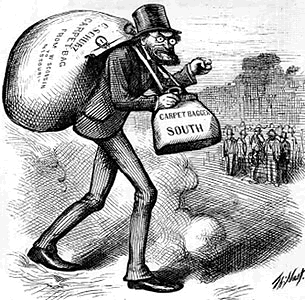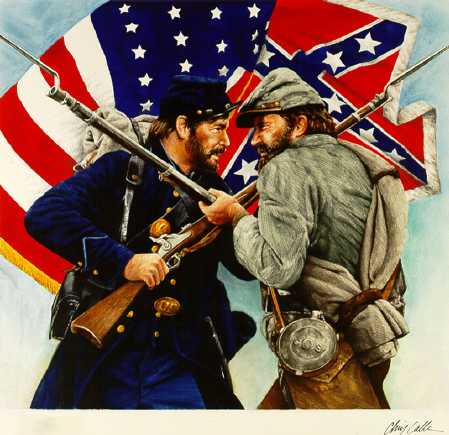The Black Codes were their to ensure availability as a labor force for slavery that had now been abolished and it was also designed to restricts activity's for freed black slaves. The Northern outrage for black codes undermined Johnson's policies. There were Jim Crow laws that said the white and blacks should have separate laws.

After the Civil War the Northerners were after money and jobs. Because of this, many of them traveled to the South after the new jobs that slaves had left behind and the land that now had no owners. These people were called "carpertbaggers" by the South. "Scalawags", as they were called, were Southerners who supported the Republican view of the best way of Reconstruction in the South.

The South's Reaction: The south reacted with violence with the Ku-Klux-Klan. They dressed in white hoods and robes to make themselves look like ghosts, then rode around at night threatening blacks to keep them from taking advantage of the new rights which the Klan thought that they should not have. When that did not work, they went around and beat and murdered. The government convicted more than 1200 and arrested thousands.
Sharecropping: Developed for economic answers to the depravations of the South. There was different arrangements which consisted of labor-leased land which provided their own tools and seeds and grew what they wanted too. They also paid the rent with cash or crops. others provided only labor.
Redemption: The people wanted Congressional control. redeemers were men who led the fight for freedom from the radical rule. Redeemers could sometimes be unfair , which an example is carpetbaggers and scalawags. Some redeemers wanted to strip blacks of their rights and privileges that they had gained since the war. Some supported black codes and the rise of the Jim Crow Laws, and most redeemers wanted to achieve what they considered fair play. They wanted to elect their own governments and run their own affairs without outside governments. Not all redeemer governments were like Hampton, for example Ben "Pitchfork" Tillman, who followed Hampton for 10 years as South Carolina's Governor. Tillman was an open racist who wanted to use racial turmoil to help his further political ambitions. One by one, southern states had redeemers as their leaders and regained control of their states.

